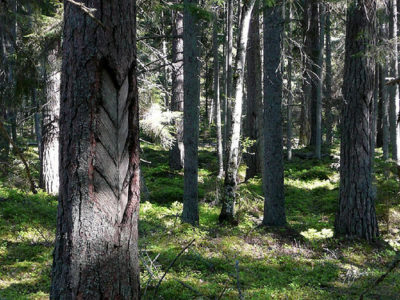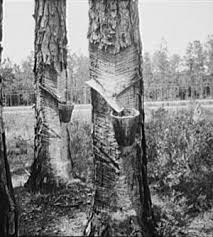
The resin is exudative product of some plants. Natural resins are usually of vegetable origin and are characterized by a solid composition at room temperature, insoluble in water and partial or complete solubility in the alcohol. Resins in nature occur primarily or by secondary or exist as such in the resin canals plants, and serve as a defensive asset when incurred injury, or secondary secreted under the influence of external stimuli: incision, scraping, etc. A secondary method of obtaining the resin is the main method of world production.
The resin is produced in all conifers except Fir and Yew. All kinds of of pines have a lot of resin that is collected in a special way.
The resin is in resin bags and cell walls, and in the bark conifers.
Pines resin is exudate, which leaks from the pine tree when he gets a hurt surface. The main ingredients of raw turpentine are: turpetine oil and colophony.
Methods and techniques obtaining resin
- Subject to obtaining resin is only the lower part of the tree, up to about 4 m high.
- The main work in obtaining resin is done during the growing season, from early March to late September.
- Special tools, sharp blade on the tree opens the wound from which the resin begins to leak.
- Approximately every week, this wound renewed and extended, or opens new wounds.
- Leaked resin takes on certain containers, and from them is poured into larger containers and shipping in the factory.
Most resin has at the transition between the root of the above-ground part of the tree. Still going toward the crown, the amount of resin drops and in the crown again increases, then decreases again towards the top of the tree. For practical collection of resin, the most important is the lower part of the tree from 3m to 5m high. The heart is the richer with resin from the sapwood, and peripheral parts than interior.
The yield of the resin, is the quantity of resin which is obtained by wounding the systematic (incising) and the drilling during one season of collecting the resin.

The yield of the resin depends on several factors:
- Natural factors are: meteorological, biological, breeding, geographical.
- Technical factors are: a way of collecting, the workload tree, the frequency of cuts.
The consequences of collecting resin:
- growth of the tree;
- physical and mechanical properties;
- yield and seed quality;
- the occurrence of plant diseases
- the occurrence of bark beetles.

The subject of scientific and technical considerations shows that the growth of these trees was lower by about 20% of the increment of trees that are not used for this purpose.
When collecting resin incising trees it is physically damaged. The degree of damage to trees, ie its lower part, depends on the sequence of forming the cut. There is an assertion that the collection of resin have positive effect on the mechanical properties of the tree:
- elasticity
- resistance to pressure
- resistance to breakage
- torsional strength, etc.
Collecting the resin, trees are wounded, and wounds are the perfect place to attack microorganisms, and thus leads to weakening of the physiological function tree from which collects resin.
The smell of resin attracts insects. However, if the collection properly executed detrimental consequences are negligible.

